A New Beginning: Coming Full Circle
Our miraculous journey shared with wonderful friends
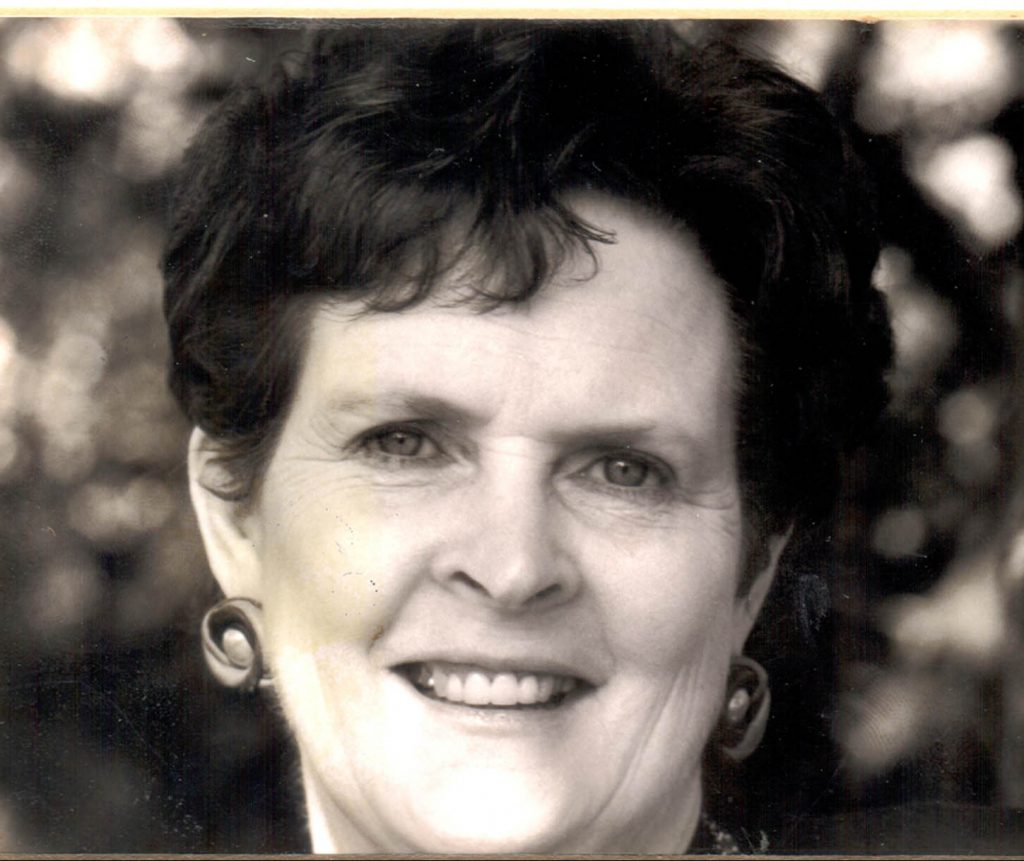
CATHOLINE BUTLER pictured shortly after we launched The Celtic Connection in 1991.
By CATHOLINE BUTLER
On February 24, 2020 when the combined March/April edition of The Celtic Connection rolled off-the-press and was dispatched out we were relieved knowing that it would soon be in the hands of our readers with plenty of time to let them know about all the upcoming St. Patrick’s Day celebrations.
Little did we know that in one short week our lives would be turned upside down and changed utterly… the coronavirus pandemic had arrived!
There would be no St. Patrick’s Day celebrations for 2020. The other crushing reality was that we had just dispatched out our FINAL print edition of The Celtic Connection.
The situation with COVID-19 was traumatic enough, and in fact it remains so, but was this to be the end of The Celtic Connection?
For quite some time now we could see that print media, especially for smaller publications like ours, was becoming increasingly unsustainable but the pandemic has led us to explore other avenues.
One of those avenues is our ‘New Beginning’ website which starts with a reflection on nearly 30 years of history. As with any new undertaking we don’t know where this will lead but it’s an exciting prospect.
Our Dedicated Support Team
From the beginning I was involved with many aspects of the newspaper, this included answering incoming telephone calls, selling advertising, doing interviews, writing articles, and finally managing distribution of the paper.
We would joke among ourselves that we had an unwritten law that no sick time was allowed during production. This included medical procedures and the birthing of babies since everything needed to be scheduled to accommodate our press dates!
Christine Burke, our graphic artist for many years, became pregnant twice while working on the paper. Each time with trepidation we asked her due date before offering congratulations. We all breathed a sigh of relief when her babies accommodated our schedule and waited to be born until after the paper printed.
A number of other great women have also worked on our graphics team over the years, including Christine Byrne, Ainsley Baldwin, and finally Thary Chhom.
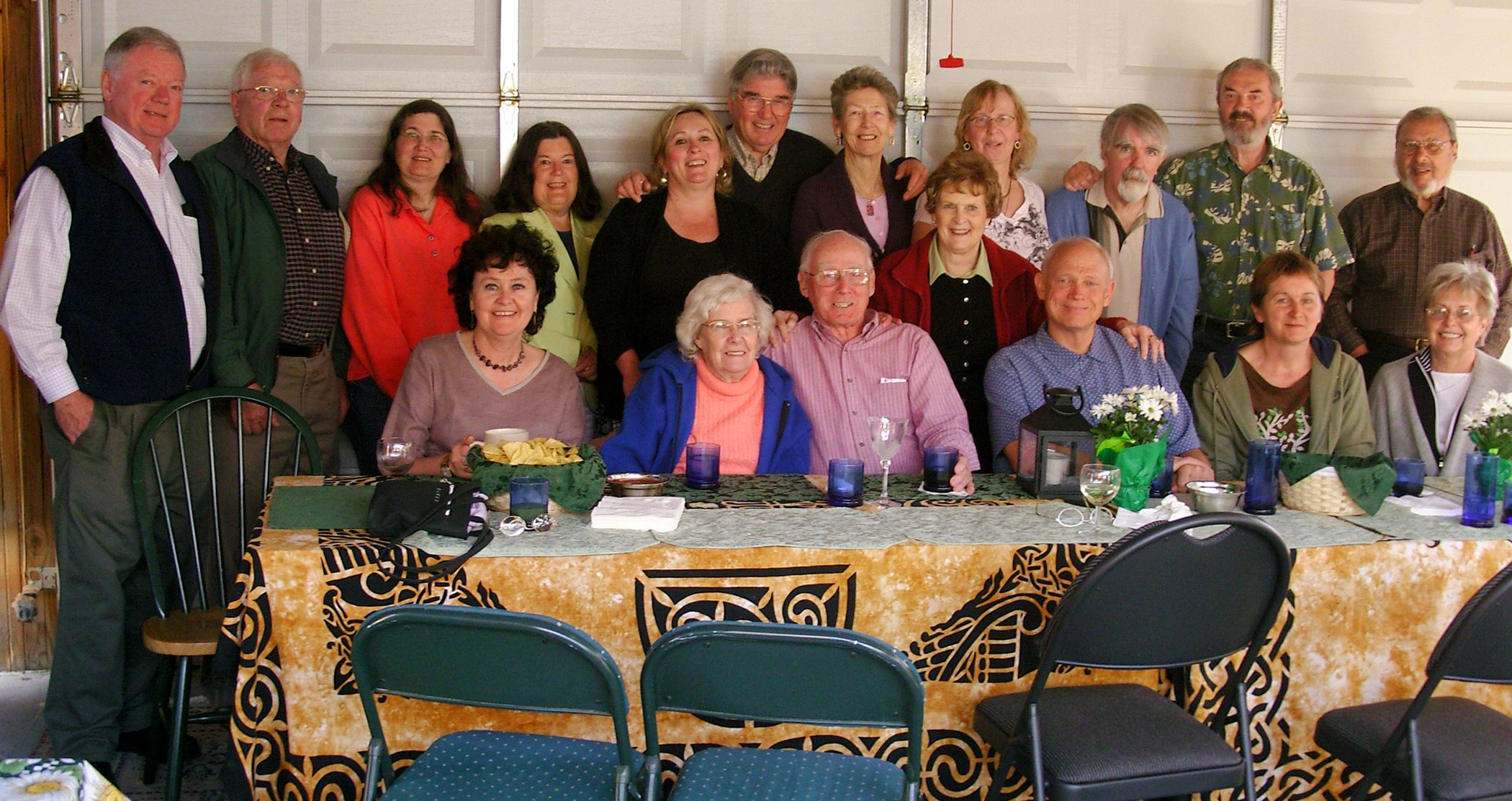
GUESTS at a volunteer appreciation barbeque in May 2009 (L-R) [Standing back row]: Neville Thomas, Tom Butler, Colleen Carpenter, Mavis Williams, Maura De Freitas- McCay (Editor/Publisher), Bill Duncan, Kareen Duncan, Catholine Butler, Joanne Long, Jim Carbin, Kevin Boggan and Eifion Williams. [Seated] Sharon Brown, Bernice Carracher, Bill Carracher, Doug Medley, Stephanie Boggan and Cathy Thomas. [Missing from the photo is Angie Park.]
Offering to volunteer was dangerous because before you knew it you had a job delivering the newspaper in your own neighbourhood.
Over the years, countless people worked to help ensure each issue of The Celtic Connection reached our readers – far too many to mention – but we are forever grateful to everyone for your support.
Some of those on the Celtic team at our office included: Mike Paul of the Scottish Cultural Centre who helped with distribution; Steve Edge of the Rogue Folk Club was both an advertiser and contributor. He loved the tea brack I kept on hand, maybe because I made it with Irish whiskey; Jack Wallace worked on design and layout with Maura; Alicia Martin worked on proofreading and editing; Deirdre Keohane, an Irish/Canadian artist contributed much of the early artwork for our front covers.
Other volunteers in the office included: Teresa Croke; Marie Bruce; and Lucy Cullen. Most days Lucy would bring her lunch to the office. We worked in a heritage building on West Hastings Street and when we opened our windows we had seagulls nesting nearby who would watch us with curiosity. One in particular would sit on our windowsill and watch us working so we named him Percy.
One day Percy seized the opportunity when Lucy opened the window and her lunch was within snatching opportunity. Quick-as-a-wink Percy grabbed the bag and was gone to dine on Lucy’s lunch….we never trusted Percy again after that incident.
To help to sustain the business we sold Celtic jewellery, Claddagh rings, and Bewleys fruit cakes.
Jim Rochfort would often drop by the office and just to get a rise out of me would ask if I had any more of that maggoty cake left. Of course, my cakes were not maggoty and he always bought one. Jim was a great supporter who was also drafted into distribution.
One late night I had a particularly frightening experience when I inadvertently locked myself in the office with a robber.
When I arrived I noticed the door was unlocked and the lights were still on but thought it was probably Richard Carrick, a young fellow who also worked on the paper with us. I called out a hello to Richard a few times but no answer so went around to investigate.
A man suddenly ran out from behind one of the filing cabinets and pushed me into a desk before rushing out the door.
Next, I discovered that our Claddagh rings were gone. When the police arrived they told me I was lucky that I was only shoved out of the way.
This was when I called Maura and told her to come down straight away and bring whiskey!
During those years, we experienced so many touching gestures from people.
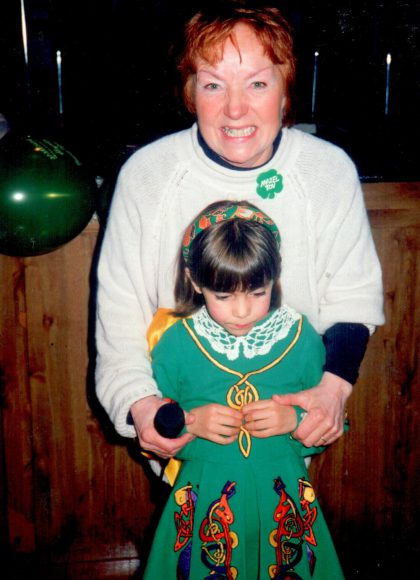
VIOLET MOORE with one of her young dancers with the Moore School of Irish Dance.
On another night in particular, when Maura and I were working late, Violet Moore of the Moore School of Irish Dance stopped by
She asked if we had eaten because she wanted to take us out for dinner. We were hungry and the offer was so very tempting but we were on deadline and so had to decline.
When we first started shipping the papers to Seattle, Brian Keys then-owner of Quick Shuttle Bus said that since we were just trying to get established he wouldn’t charge us until we got up and going. You won’t encounter that kind of generosity every day.
We are deeply grateful to so many people and businesses who helped us and we remain indebted to all those supporters who continue to help us to this very day.
There were many times we questioned if we would be able to carry on financially. One particularly difficult time I went in to speak with the pastor of my parish, Father Mohan of St. Augustine’s Parish in Kitsilano.
He told me that if we always included a prayer to Our Blessed Lady in the paper that we would never go bankrupt but would close down when we were ready. The coronavirus helped to make the decision for us but somehow we never went bankrupt.
Adventures with Distribution
Despite the challenges, there was always a great sense of satisfaction when we opened each new issue knowing we had done it again for another month and it was on its way to our readers across Western Canada and the U.S. Pacific Northwest.
Distribution was always a new adventure for Colleen Carpenter and myself. So much so, that if things went too smoothly we were always waiting for the next shoe to drop.
It always involved a lot of advance co-ordination to ensure the paper was ready to go for our drivers when they arrived as they were always in a rush to get out and start delivering to their various routes.
We had some regular drivers that we never had to worry about such as Linda Robb and Allison Moore. They were veterans and knew their routes by heart.
Joanne Long in Mission also delivered to a large territory in the Fraser Valley. She took over the Maple Ridge route after her partner Jim Carbin passed away.
In addition, she later took on Bill Duncan’s territory when he also died. After Bill’s demise, his wife Kareen continued to allow the papers to be delivered to their home for pick-up by Joanne.
Deirdre O’Ruairc, along with members of the White Rock Irish Club, delivered the papers in White Rock. Some of the others who have helped in White Rock include Sharon Woods, Gerry O’Keefe, Mary and Ray Fynes, and Sandra Nesbitt.
Eifion Williams of the Welsh Society delivered in east Vancouver. He took over from the late Neville Thomas of the Dylan Thomas Society. Neville was a great supporter of everything Welsh in Vancouver and organized the annual reading of A Child’s Christmas in Wales at the historic Cambrian Hall.
Frank Dudfield delivered throughout Surrey, while Oliver and Marilyn Grealish delivered the papers in the Edmonton area for many years.
We always enjoyed great support from members of the Irish Heritage Club and John Keane in Washington State. Many members have helped distribute The Celtic Connection in Seattle, including Jane Sepede and Nanci Speaker. Heather Murphy and Dave Jacobsen most recently delivered the papers in the Seattle area.
Others who volunteered with distribution over the years included Rory O’Sullivan, Paddy Connolly, Kevin Boggan, Art Marshall, Dermot Byrne, Gabriel Clarke, Laurie Lang, Doug Medley, and, of course, Tom Butler.
We always felt very confident when our regular Quicksilver Courier drivers Bo and Hazel picked up because we knew they would get our papers delivered on time.
Arlyn Lingat worked overnight with each issue to get the papers organized for our subscribers. These would be picked-up the following morning and delivered over to the main Canada Post distribution centre.
It was always a mad dash to work around the bus schedules. Before Greyhound shut down, Colleen and I would take papers to the main depot to ship across Western Canada. Then, we would take the Seattle papers to downtown Vancouver for shipment on the Quick Shuttle bus.
Catherine Flynn who often helped with distribution came downtown with us on one of those memorable trips, this time in the middle of a snowstorm.
In an attempt to clear away the snow from the front windshield, Colleen was shocked to find one of wipers in her hand. She had accidentally it pulled off but disaster was averted when somehow she was able to reattach it in the driving snow.
On another occasion we found a construction zone where the bus was supposed to stop. Colleen ran into the Holiday Inn where it usually stopped to inquire where the stop had been moved and in her haste she ran straight into the glass door.
She bounced back but just kept going to make the bus…and that’s the way it was at The Celtic Connection!
Each day presented new challenges to be overcome and really little did we know yet how many of those challenges there would be or the amount of work ahead of us. Good thing we didn’t or we might have looked for the nearest exit.
Interview Highlights Over the Years
Recently, I’ve been reflecting on some of the remarkable people that I was privileged to interview over the years. The resilience and energy of the Celtic people and their achievements never ceased to amaze me.
As immigrants to Canada and the United States they brought their music, their songs and dance along with them. They established new cultural infrastructures in their adopted communities to maintain their links with home and were instrumental in the formation of many of the clubs and organizations enjoyed by a new generation of immigrants today.
I heard countless interesting stories from those people and many of the pages with those interviews can be found posted in the photo gallery on this website.
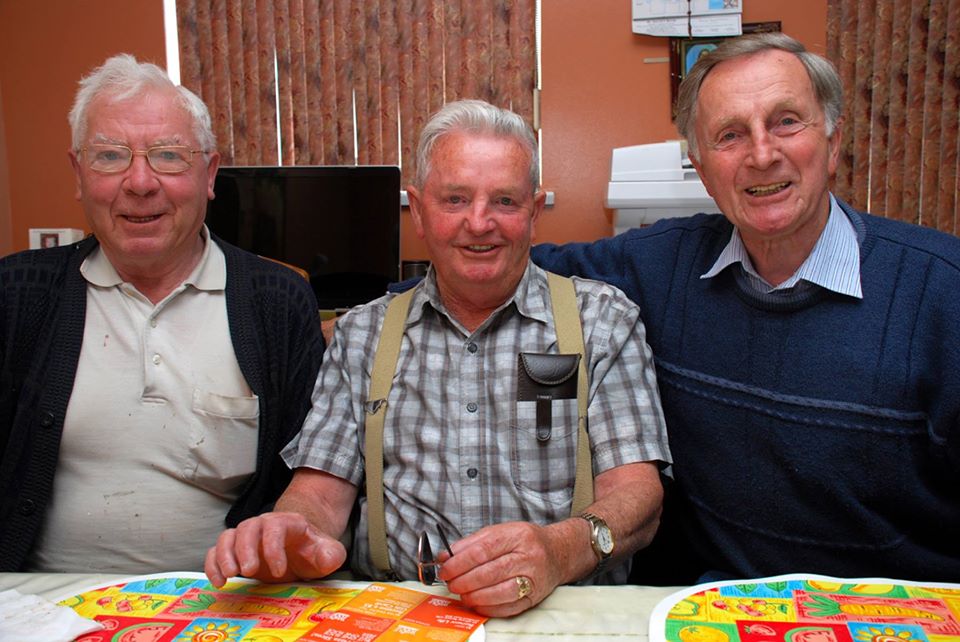
‘THE THREE TOMS’ was a series of engaging interviews of historical interest by Catholine Butler featuring three old friends: (L-R) Tom Butler, Tom Scanlan, and Tom O’Flynn.
One the most engaging and entertaining was a series of interviews I did with three old friends – Tom Butler, Tom O’Flynn and Tom Scanlan. The three had immigrated to Canada in the 1950s and they were delighted to share their memories of home along with the folklore and customs of old Ireland.
Among those memorable people was Chris Whelehan in Edmonton. He launched a highly successful modular home business with customers around the world. He also helped to establish the Wolfe Tones GAA Club and was a passionate supporter of the Gaelic Games.
In Seattle, the late Mick O’Malley established a thriving construction business in that city. As a young man in Ireland, his dream was to immigrate to South Africa.
He applied for work there but waited in vain for a reply. Finally, when no letter arrived he immigrated to the United States.
Years later he learned that a letter confirming work had indeed arrived but his sister didn’t give him the letter because she didn’t want him to go to South Africa.
Mick was a strong supporter of the Seattle Gaels GAA Club and all things Irish in Seattle.
John O’Beirne, owner of the Mad Hatters Superstore, established shops throughout Western Canada which cater to women and men’s accessories. John is very humble about the empire he has built and the resulting employment he created in those various locations.
Ethna Tutt the former president of the Okanagan Irish Society is a mover and shaker for all things Irish in the Okanagan. She helped to establish the first Irish dance school for children in that area. Not only that, she sewed and hand-embroidered the first costumes worn by those dancers.
William Donnellan founder of IRL Construction and Donnellans Irish Pub in downtown Vancouver has continued in record time to add more businesses to his portfolio since arriving in Vancouver.
William is a passionate hurler and supporter of all GAA games. He helped to establish the JP Ryan’s Hurling Club in Vancouver.
Patrick Reid was a gracious man with a witty sense of humour and he shared his fascinating life story and travels around the world with readers of The Celtic Connection.
Reid played a prominent role in so many key moments of Canadian history that touch the very heart of what Canadians hold so dear – particularly the creation of the maple leaf on our national flag.
In addition, as director general of public affairs with the Department of External Affairs, he accompanied the Canadian hockey team to Russia in 1972 in the momentous series between teams representing Canada and the Soviet Union.
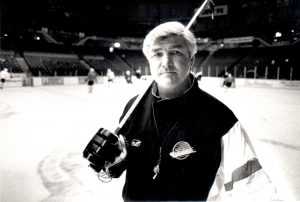
BRIAN BURKE spoke of his pride in his Irish heritage when he was coach of the Vancouver Canucks hockey team in 1993.
Other major figures in the world of hockey that I interviewed for The Celtic Connection included the late Pat Quinn and Brian Burke.
Pat Quinn was the coach of the Vancouver Canucks hockey team. I recall shaking hands when I met him and my whole hand just disappeared into his very large hands.
He was very proud of his Irish roots and was known by the nickname of ‘The Big Irishman’…I could see why. He also told me that he and his family had much enjoyed a visit to Ireland.
Brian Burke was director of hockey operations with the Vancouver Canucks and he also was very proud of his Irish roots. I recall him telling me that one of his favourite dishes was a New England style boiled dinner.
2001: A Year We’ll Never Forget
On September 9, 2001 we has just published that issue and were busy getting ready to distribute the papers.
Colleen came to work early that morning and when I opened the door she was in a state of distress. She said, “the U.S. is under attack.”
We quickly ran to turn on the television just in time to see the second plane hit the World Trade Center in New York. The whole scene was surreal, unbelievable, and horrifying.
We managed to continue distributing the papers that day but soon learned the U.S. border was sealed so couldn’t send to Seattle.
In the aftermath, two very sad interviews remain in mind which encapsulate the events which became known as 9/11.
The first was Eoin Kennedy, manager of the Eastern Region and Southern U.S. States for Tourism Ireland. He was based in New York and was present in the city when the attack took place. He recalls the shock and devastation of that day.
The other was Michael Hurley (former president of the Irish Sporting and Social Club of Vancouver and now Mayor of Burnaby), who was a firefighter in Burnaby at the time.
He had recently returned from New York City where he had attended several funerals of brother firefighters who had perished at the World Trade Centre.
EOIN KENNEDY
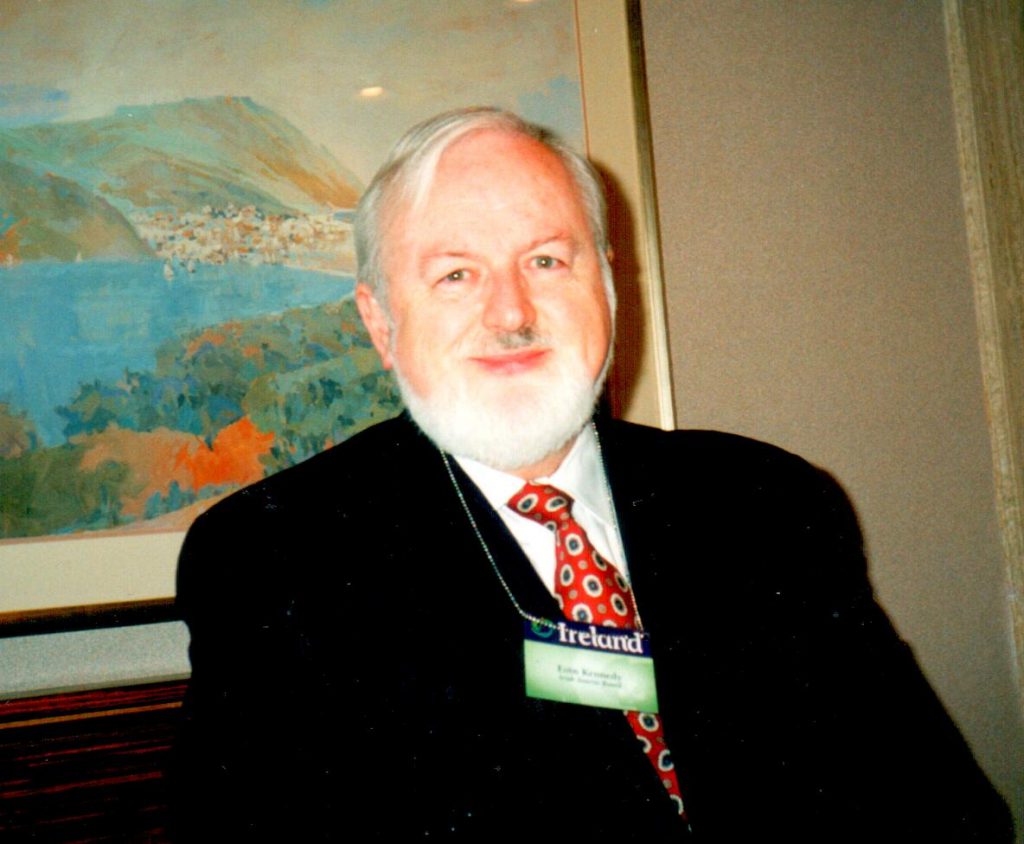
EOIN KENNEDY, manager of the Eastern Region and Southern U.S. States for Tourism Ireland, spoke to Catholine Butler following the devastating 9/11 attack on the World Trade Center in New York City.
In the days that followed 9/11, Eoin recalled, “There’s a pervasive sadness in the city. The terrorist attacks have had an enormous ripple effect on many people. It is estimated up to 4,000 people died in the World Trade Center but those figures are debated daily
“The impact on those families is far reaching, since there were people from up to 60 to 70 different countries among the dead.
“I have heard as many as 300 Irish or Irish-Americans were involved or died in the disaster. As you know, hundreds of firemen died and a huge portion of them were Irish.”
He said, “The New York Times now prints a daily page entitled ‘A Nation Challenged’ which features a brief biography of about 20 or 30 people who were killed at the World Trade Center. It’s a small paragraph about who the guy was, what his job was, his life, his family, his hopes, his dreams, his hobbies and a passport size photograph.
“So many of these guys were in their thirties and fathers of young families. Oh, my God, it’s gut-wrenching reading this every single day – day-after-day.”
He continued, “Actually Catholine, I’m a grown man in my late fifties and I could just cry reading The New York Times coming to work every day. At the bus terminal there’s a whole new altar of flowers every day.
“Then, as you walk through the city on the way to your office, there are fire stations covered with more flowers and candles. I just want to get in to the office and stand in front of a window, take a deep breath, and have a cup of coffee. You just say to yourself, ‘Oh God, how the hell do we continue?’”
Kennedy’s offices were located in Ireland House just across the street from a firehall at Lexington Avenue and 51st Street.
He said, “out in front are pictures of the firemen who were lost in the Trade Center, along with more candles and flowers. Every single firehall in the city has lost from one to five firemen…the stories are heart-wrenching.”
He described the scene saying, “My wife Claire and I went down to Ground Zero and the area is as big as 10 football fields and the debris is almost 100-feet high in some places. It’s staggering to just stand there and see the destruction.
“The smell is dreadful, the dust tickles your throat, and your eyes begin to sting. It’s like you would expect to see after an atomic bomb. It’s an extraordinary sight and your jaw just drops open. You’re left feeling stunned, thinking ‘God Almighty, this thing is unbelievable’.
“There are thousands of dead still there and I think personally they just vaporized at the thousand degree temperature. The one thing they continue to find is a lot of jewelry and among that a pile of Claddagh rings has accumulated.”
In closing, Eoin said, “I’m sorry to sound so depressing, but that’s the way it is. It’s like nothing we have ever experienced or prepared for. It’s one year we’ll never forget.”
MICHAEL HURLEY
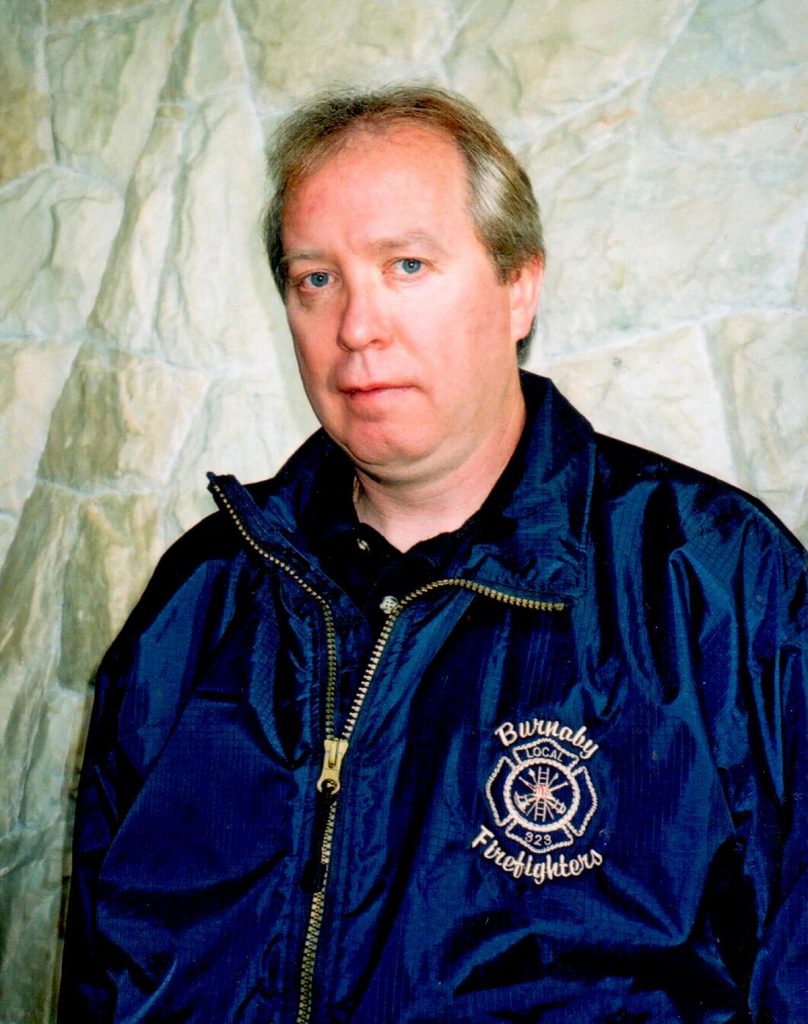
MIKE HURLEY who is now Mayor of Burnaby was chair of the Irish Sporting and Social Club of Vancouver and president of the BC Provincial Fire Fighters Association when he spoke to Catholine Butler following his return from New York City in 2011.
From 1996 to 2001, Michael Hurley was vice president of the Burnaby Fire Fighters Association and president from 2001-2009. He was also the president of the BC Provincial Fire Fighters Association from 2008 – 2016.
After 9/11, firemen from throughout North America went to New York to help in whatever way they could. Mike Hurley went along with firemen from Edmonton, Calgary and Seattle.
Hurley made two trips to New York and he spoke to The Celtic Connection after one of those trips.
He said, “I went to New York twice now, more or less to support the firefighters down there and to attend funerals.
“Because so many firefighters died at the World Trade Center, they’re having a hard time trying to get enough uniformed personnel to attend funerals because of having to cover the extra work shifts of their fallen comrades.
“I attended about 30 funerals while I was there and since there are still 344 funerals to go – that’s almost one funeral a day for a very long time. It’s a very emotional experience. It was hard seeing all those kids without fathers.
“You see so many little kids coming out of the church carrying their dad’s helmet or part of their dad’s uniform, and maybe the widow gets up to speak about her husband and it just tears your heart out.
“We had an opportunity to speak with some of the kids and a few of the wives, but they’re all so devastated they had a hard time even discussing it at that point.”
Mike continued, “You hear so many heart wrenching stories of family members looking for loved ones that died in the Trade Center. We were told of one woman whose husband was of Irish descent and she wanted some part of him as closure for his death.
“She asked the emergency attendant at Ground Zero site if they were able to find anything belonging to him. The attendant asked her if there might be anything that would stand out as belonging to her husband. She said ‘yes….a Claddagh ring.’
“The attendant said, ‘I’m sorry to tell you this and I don’t want to hurt your chances, but that will be up to 200 Claddagh rings that we’re looking for now.’ There was a lot of Irish involvement down there.”
Continuing, Mike said, “I’m originally from Northern Ireland, so I’ve seen a lot of explosion sites, but nothing can prepare you or describe what Ground Zero looks like.
“It’s an 18-acre site, and to put that into perspective, if you look at Brentwood Mall in Burnaby and all the parking lots, it’s about that size of an area that’s been devastated.
“On my arrival home from New York, the first thing I did was to give my daughter a big hug and tell her how much she means to me. As a firefighter you always know that at any time this could happen to you…but that’s our job.”
Thank You, I’ll Miss You!
In closing, I would like to say that we’re eternally grateful to our advertisers and our many original customers who remained with us throughout the life of The Celtic Connection.
I really enjoyed talking to each and every one of you, and along with our dedicated subscribers that is a connection which I will greatly miss.
If our ‘New Beginning’ website is anything like the past 30 years…buckle up! It’s going to be an interesting journey.